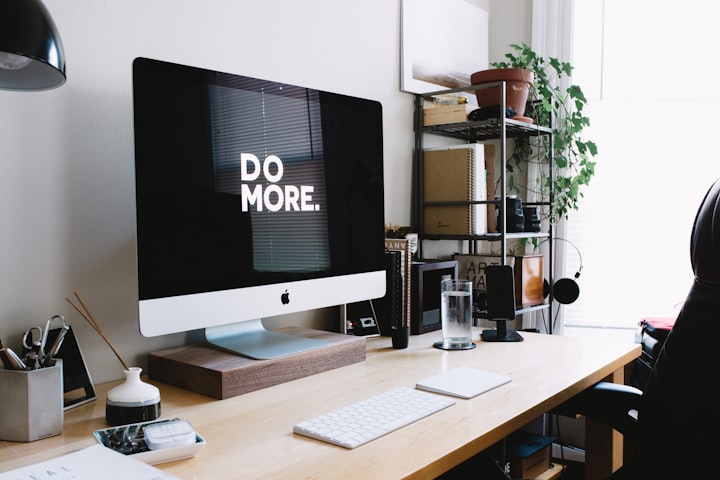Ways to keep yourself productive in your Home-Office settings
Things to Follow for a Greater Life-Work Balance

For most of the people who didn’t have the chance to work remotely previously — the thought for a home-office / remote-work scenario might be something like:
“A relaxing day! You are laying on your bed in your pajamas, laptop at your side while checking your emails, connecting with peers or clients (if required), or doing creative work, while adjusting your pillow or attending a virtual session while your NETFLIX is running on TV.
Your pet-dog is roaming around with his/her disciplinary routine (no barking etc.) or the pet is just beside you and your hands on its head, calming it while designing the project work. Your kids are surprisingly quiet and busy with story-books or their play-chores.”
Come to reality — the real experience is far away from these illusions, right? Due to the pandemic scenario going around the world, the work dynamics have suddenly changed — causing more and more people to work from home. And, as it is a new mantle for most of us, we are struggling to cope up. All of a sudden — (for some or most without home-office experience), all hell breaks loose & the illusion turns into a different state.
Remote-office work is being there for a number of years already, obsoleting the regular office-based work scenario in some of the industries. According to Forbes in one of their 2019 articles- renowned organizations like Amazon, Intuit, Appen, Kelly Services, Dell, etc. have embedded this work culture for their relevant divisions.
They have also incorporated this style for most of their divisions too for enabling flexibility, employee satisfaction; plus foster easier executions. Debates were there whether this style works better or performs worse; not only across industries but also within industries where the norms were already being established.
Rollback to the current scenario, the discussion for today is: how businesses are making the transformation and what is the simplest way to ensure maximum productivity. Organizations are monitoring the current state of work within these parameters to track the success and results; so that after the situation gets better — they can compare & contrast it with regular office-work style and take a better decision (transform) for the future.

The lists I’m about to provide are tested by multiple experts or remote-office based entrepreneurs. To be on the safe side, I have tried out most of the listed essentials (except the suggestions for the parents to manage their remote-office time) and I’ll recommend adjusting the list based on your work-pattern.
Try these out, test whether these are flexible enough to be adjusted for your work-pattern and see the result for yourself.
1. Create a designated space for your work (if available space is there).
Because you have to. If you can’t separate it, your mind will not be able to distinguish regular office-hour and extended office hours & you might end-up working from your bed or living room sofa, with your NETFLIX on along with your laptop on the side. The other reason is, it will help you to keep your work neat & clean, along with maintaining a strong discipline.

Separate work-space will also boost your productivity, as you will not be looking for things here and there.
Make sure, you have ample light coming inside the room (from outside or room-lights), have a workable table to keep your essentials in place, a good chair to sit appropriately, and your adapters and chargers in a convenient space.
Separate work-space doesn’t mean that you require an additional room- even within the shared space, you can create a zone for accessing your office-work.
2. Prepare a schedule to follow.
A top-line time-table is required at your end. Along with in-person or virtual meetings, it will help to slot out the activities you are about to perform during the office-hours effectively. Make sure you are getting up from your chair every 1 hour to reduce the chance of back pain.
Close your eyes for at least 5 minutes every 2 hours (if you are looking at your personal computer/ laptop constantly). Drink water at an interval to keep you hydrated (and it will help you take your washroom breaks at a regular interval). Take your breaks (& take it entirely).
3. Boundaries to put.
As you are doing your work from home, you are sharing your space with other people in the house and you require to set some boundaries to get the work done. Due to the current scenario, you might be sharing the home with all other family members at the same time. Be sure to go on breaks and interact with the family members, but also inform them about your designated work-space and time-schedules to maintain.
4. Dress for success.
Now, this is debatable for some. The reason it made it to this list is that when you put on a formal dress or dress for success, it reflects in your work and throughout the day to maintain your motivation. You are also triggering your mind to set the office mode-on. Also, the formal dress makes you a bit less relaxed, which prevents to take a NETFLIX break or keep yourself floating in your sofa-bed into sleep.
On the opposite side of the story — you should wear relaxing clothes to work comfortably and efficiently. Formal dresses throughout your remote-work keep you in pressure and anxiety, based on some experts’ opinions.
In my opinion, wear a comfortable dress to work without anxiety and if required for virtual meetings/conferences, wear appropriate semi-formal, only for the session. One important note, change into comfortable clothing from your sleeping dress before you start, as you require that boundary for a mental drive of work.

5. An early start of the day gives you a heads-up.
It’s not a race, so the reason it’s mentioned is that you need to mentally prepare for starting your day rather than just jumping from your bed to work or just turning-on your laptop to reply to office emails.
If you wake up a bit early, you might take a quick walk around to face the day (keeping your physical distance in this dire-scenario), can prepare and have a home-made breakfast, might listen to music in your headphones or might just check social media craziness before starting your engine.
It also helps to check your planned schedules for the day & also relaxes you before the busy day ahead.

6. Check-ins & virtual team-meets.
This one will depend on the work type, work engagement style & organization culture (along with the notion of the time-zones if dealt with multinational clients/ colleagues). For most of the teams who are working for a regular office-hours, this might be a life-saver for the team-leaders.
Video- conference or online team-meeting session really helps out!

Personal check-ins for the remote-work is important to keep the production running and to keep the team discipline. It also encourages people to respect their norms. The easiest way to keep the check-in is virtual team-meets for the scheduled meeting days.
Technology has enabled us with a different mode of work and there are lots of relevant office applications out there to support the virtual meetings; like — Microsoft teams, Zoom, GoToMeeting, Cisco WebEx, Skype for Business, Slack, ReadyTalk, Trello — you name it. With these advents, Virtual team meetings enable the team discussion, official communications, problem-solving sessions, and/or any other relevant brainstorming easier these days; so why not grab the opportunity?
7. Log your time & work for productivity tracking.
Apart from the official check-ins and record-keeping software, you should keep track of your work for other purposes too. There are relevant integration tools like Trello, Basecamp, Evernote, etc. which are easier to work smoothly with different office solutions.

There are automatic time-tracking apps like Toggl, RescueTime, EverHour — which allows you to check in on whether you are in-line with your planned schedule, helps to identify the most productive times of the day along with different other features.
Again, these are not mandatory and not prescribed for the personnel — who works better in their adaptive schedule. Because it is easy to get distracted when you are effectively your manager for completing your tasks, I’m mentioning these tools if deemed required.
8. Restrict social media usage.
To avoid the boredom in between the work, we often depend on the powerful handheld devices (aka, cellphones) and their installed apps to move to powerful social media. And what happens in most of the cases — you either lose track of scrolling your newsfeed or being distracted with powerful news/stories, which impacts the later works.

So, if possible — keep your personal phone in a distant place, check only in-between the breaks (that’s what breaks are for), and in the end, engage in your daily work challenges with undivided attention. If the phone requires to be on your work-station, apps like Forest and Zero Willpower can help you to not let you check your phones that frequently.
The choice is yours, my friends!
9. Lock a personal development time.
Look, it’s all about equipping yourself for a better tomorrow — so it’s a must list.
Suggestively, keep a time-slot to develop yourself as a professional every day. It might be knowing new information, might be reading relevant articles or features, might be getting online training about business/products/habits/trends / skill-sets, etc. It could be a brainstorming session with team members for a project with a project expert, might be a demo session for a software solution, so on and so forth. If you are doing it within your regular office-hours, make sure it is relevant to your business or industry; if it is outside the regular hours — the world is yours to explore.
I mean, it might a TEDx lecture, a NETFLIX documentary or YOUTUBE video of Kurzgesagt — In a Nutshell, you decide.
10. Healthy habits to follow.
Here goes a list of healthy habits (without detailed description) you can follow –
· Have a healthy dose of daily water intake; check your caffeine intake.
· Watch for your stress level (if you are feeling stressed, take a break & divert your mind onto something before getting back to work).
· Have scheduled breaks and take the breaks fully.
· Follow a scheduled meal-plan (means, the intervals to have your lunch, in-work meals, etc.).
· Keep table foods to keep you motivated (should not include high calorie, addictive items — which generically keeps your energy level down).
· Get up from your chair or workstation after every 1.5 hours at-least.
11. End with a high-note. And, before closing- validate the next day’s plan.
Positive ending sets-up the tone for the next day and level-up your motivation — as we feel the sense of achievement. You can do it in several different ways: a) keep a task/activity that doesn’t require immediate attention, but has a high probability of success when you finish it or b) keeps a couple of tasks with a high probability of completion with a positive note, so if the scheduled one doesn’t get the desired positive ending — you can work onto another task to ensure the successful completion and achieve the feeling of accomplishment.

Before signing-off from your workstation, please make sure that you go through the next day’s schedule at a high-level. It helps you to prepare accordingly (i.e. plan adjustments, task assignments, appointments/sessions re-scheduling, etc.) and ensures a solid mental map for the next day.
Psychologically, you will be more confident and will be relaxed for the rest of the day.
Other useful tips you can incorporate.
· Schedule email check-out time (scheduled email check time), as checking emails every-now-and-then distracts regular work.
· Confront the relevant tasks you have been putting off for some time.
· Set time for unproductive office works, but within the office hours.
· Interact with colleagues, peers in regular hours, and with people inside your home in the break-times (will keep you motivated, engaged, and less stressful).
· Take a walk or go outside your house (if possible and without any gathering) to get the fresh air and to energize your mental health.
· For people like me, a whiteboard to list the task and cross-out once ended (mental win vs the obstacles).
· Your remote work technology infrastructure should go through a stress-test, meaning it can support the model or work pattern your remote sessions demand to continue.
Parents at work: Now, the question that will come: what if, you are a parent and you have to manage your work, while kids are at home.

The following tips might be helpful for the parents, which I’ve compiled by doing some GOOGLE search. I do not have any experience in this sector, so I will not be able to verify whether these works or not, but you can verify this by experiencing or consulting with your partner:
· Communicate expectations (to your partner, organization, kids, surrounding people, and set the expectations and boundaries).
· Get hired to help if possible (and if it is safe to get hired help).
· Plan activities that don’t require active supervision.
· Plan your schedule based on kid/s activity time.
· Take family support if possible.
· Utilize online platforms to interact with family and kid’s friends.
· Strategic screen time (really important, as an increase in screen time will affect their behavior, habits, and development).
· Take breaks according to the kid’s timeline, reward good behavior based on set expectations, create play-time breaks if possible.
· If your partner is also working from home and if it is possible to schedule shifts, make those scheduled shifts to take care of the kids.
· Have a secondary plan always, get creative in solutions, and use kids’ nap-time to your advantage.
· Most importantly, after the scheduled work-hours — spend time with your kids and family, lighten up, play games, or enjoy a cartoon, cherish the moments.
Working from home concept is not new, but for most of us — the experience is NEW.
Attaining productivity during this adjustment requires several trials and errors (to find your relevant routine to stick on) & requires your continued patience.
Employers also require to set accurate expectations and to ensure supportive interactions, while creating the remote work structures. To make it work, they require to enable the foundation of trust among the employees (i.e. empowering managers & team-members to support each other and ensuring mutual trust).
As a hyper-social creature, we have to keep in mind that psychological safety is really important in this time & as we will be engaged for a large chunk of our time doing remote-work, it is important to ensure that safety net. It will ensure that all the employees feel safe to learn and contribute, safe to challenge the status quo if required, and safe to innovate (ideas, work-pattern, executions, etc.).
So, Explore and experience the mentioned traits and decide which ones can work for you. You are the best judge at the end of the day to decide and adapt, so give some time to try out these ideas. And off-course, BE PATIENT — we all need that for the days to come.

About the Creator
Suntonu Bhadra
Travel storyteller, photographer, history enthusiast, poetic scribbler ▪ Editor of Paper Poetry ▪ I have started writing on Vocal recently.
Contents & connects: √ Medium √ Instagram √ YouTube √ Twitter √ Etsy Store






Comments
There are no comments for this story
Be the first to respond and start the conversation.